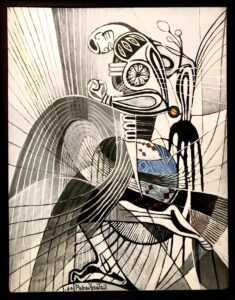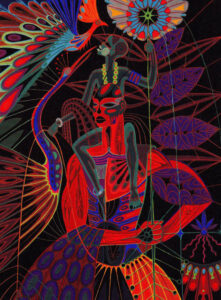My project focused on Afrocentricity by analyzing African art and poetry. I included a 2-3 page narrative of my project and how I connected the pieces to Afrocentricity, as well as a brief google slideshow of the artwork – visuals and audios.
Narrative Essay: Afrocentricity on Artistic and Cultural Display
By: Gabriel Reyes
As Dr. Molefi Kete Asante explains, Afrocentricity is a way of providing a “constructural adjustment to black disorientation, decenteredness, and lack of agency” (1). In essence, Afrocentricity requires analyzing all aspects of society through a colored lens. And in doing so, it awakens a black revolutionary consciousness that enables black and African people to examine the root causes of their displacement and its effects on the global African diaspora, while simultaneously centering the African experience in their quest for liberation and autonomy. As important as Afrocentricity is in writing, its cultural and artistic representation is equally crucial to understanding how it not only originated in black studies but also how it has evolved throughout history, as well as how different black leaders and communities have embraced it as a form of resistance. We can better understand this by looking at cultural artifacts such as poems, drawings, and paintings to see the different forms in which Afrocentricity has been and continues to be expressed and practiced.
I believe that, sometimes, art and culture are overlooked, particularly as it relates to black studies and history. African culture, in and of itself, embodies Afrocentricity in every form as it freely combines and expresses the images, languages, poetry, customs, religious practices, etc. of Africa. Throughout history, many black activists used art as a means to cultivate revolutionary thinking and promote an Afrocentric mindset/perspective in the resistance and plight for liberation. As it relates to the theory of Afrocentricity, Asante himself even writes that Afrocentricity is a paradigm that “enthrones the centrality of the African… as expressed in the highest forms of African culture” (1). Centering the African in artwork is to practice Afrocentricity in culture, and doing so allows black people to value, immerse, and take pride in their heritage and therefore use it as a driving force to change their social, political, economic, and cultural conditions in America.
The visuals I attached (uploaded here as media gallery images) entitled The Warrior and Woven Legacy were both drawn by Papa Ibral Tall. Both visuals truly resemble not only the culture and colors of Africa but also black power and resilience by displaying sharp images in powerful postures. In a significant way, these visuals are African and center African that allows African people to analyze their own culture through such artwork and gain meaning and inspiration from them.


Aside from visual artwork, Afrocentricity can also be seen in audio forms of art such as poems. For example, the text, “Let Nobody Turn Us Around: An African American Anthology”, features many poems – one of them being Langston Hughes’s infamous “I, Too” poem, which I included in my google slides powerpoint. This short poem embodies the resilience and strength of black people throughout history despite being consistently ignored, devalued, and treated as less than human. By using words such as, “but I laugh… and grow strong”, Hughes is showing strength and power knowing that he will overcome such treatment. He is, as Afrocentricity encourages, centering himself in his own conditions and artistically expressing how he will adapt to his situation. By ending the poem with “they’ll see how beautiful we are”, Hughes is knowingly instilling confidence in his poem by understanding that African Americans are essential to America’s existence and keeping America running. Such confidence embodies the vision of Afrocentricity by building a black consciousness that establishes black people as the ones in power and control of their own conditions, despite the constant oppression, and thus dismantling feelings of inferiority and decenteredness.
Link to my PowerPoint/visual and audio slideshow of Afrocentric artwork: https://docs.google.com/presentation/d/1BvxysOhoIL6Ns4IgPj4Sl3TPs9bzP12UE_RXx4y6CG8/edit?usp=sharing
Work Cited
Amendah, Hanou. “2018: An Afrocentric Art World Review.” Celebrating Creative Africa, 29 Dec. 2018, obatala.co.uk/blog/art/2018-an-afrocentric-art-world-review/.
Asante, Molefi K. “Afrocentricity.” Molefi Kete Asante Is among the Most Published Contemporary Scholars, Having Written over 70 Books and 400 Articles., 13 Apr. 2019, www.asante.net/articles/1/afrocentricity/.
“Creative Africa: Papa Ibral Tall’s Woven Legacy.” Shoko Press, 2 May 2018, www.shokopress.com/creative-africa-papa-ibral-talls-woven-legacy/.
Marable, Manning, and Leith Mullings. Let Nobody Turn Us Around: Voices of Resistance, Reform, and Renewal: An African American Anthology. 2nd ed., Rowman & Littlefield, 2009.




Hey Gabriel, I really enjoyed reading your Multimodal Project and I think you did a great job !
After reading your work, I feel much more educated on Asante’s theory on Afrocentricity, especially since I had a hard time understanding it the times I read it. I feel like you really broke it down nicely and explained it thoroughly. The first thing I noticed about your piece was how organized it was with all the information you gave. The information didn’t feel rushed and I could tell you actually tried. The most important thing I’ll remember from your project is the connection between art/culture and Afrocentricity. I really like how you mentioned that art/culture tends to be overlooked when it comes to black studies. I hadn’t thought about it before but now that you mention it, I don’t think I can name a single art piece created by an African American person, which is honestly sad. I think your project does a really great job at raising awareness about this, cause it’s honestly not fair.
I can definitely say that your project contains sufficient evidence to back up your claims. For example, I really liked the quotes you used from Asante’s “Afrocentricity” text, in order to explain what Afrocentricity is and it’s correlation to art/culture in black studies. I think it was really creative that you not only discussed visual art but also art in form of poetry. You connected the M&M reading and Asante’s Afrocentricity article in a very well put way; and in general I think the way you connected everything, from the art pieces to the readings, was just great. Everything was easy to understand and like I mentioned before, broken down nicely. Your work cited page looks perfect and it has accessible links, which is great. The only thing is that you have to make sure to add the reading section you used from the M&M reading, which in your case is Langston Hughes’ piece, within the M&M citing. I put it the same way you did the first time, but then Professor Poe said that It had to be changed, and that we had to cite the section of the reading. Besides that everything’s perfect.
Your project is very creative, and is really interesting to read. You didn’t make it overwhelming to get through nor complex, so It made the reading through it very engaging. The art pieces you chose are also really pretty and have captivating colors, which also grabs my attentions. The second one with the neon colors looks really nice, I’m glad you picked it for your project. I also like how you added the video of Langston Hughes’ poem so that the audience could hear it and understand more vividly the point you’re trying to make through your writing.
From a scale of 1-5 I rate your project’s design and layout a 5. I truly love it and think you did an amazing job. The genres you chose to communicate your writing were very creative and eye catching. The writing itself wasn’t too much and summarized the main points you focused on perfectly. The genre of your text is a narrative essay and you formatted it appropriately. You wrote to the audience professionally and delivered your points in essay form. As mentioned before the art you used was beautiful, so of course I rate it a 5. The images look clear, colorful and striking.
This project glows through the chosen Art and the explanations, in which you tied all the sources perfectly, from Asante to Hughe (etc).
It’s honestly hard to even say two ways in which your project can grow, because everything was very well put and really interesting. Personally I don’t have any grows to mention, so I’ll just give you another glow. I really love the title you chose for your project as well, as it really highlights the themes and purpose of your writing, and grabs the reader’s attention !
Overall, great job on your project ! and Happy Holidays ! God bless.